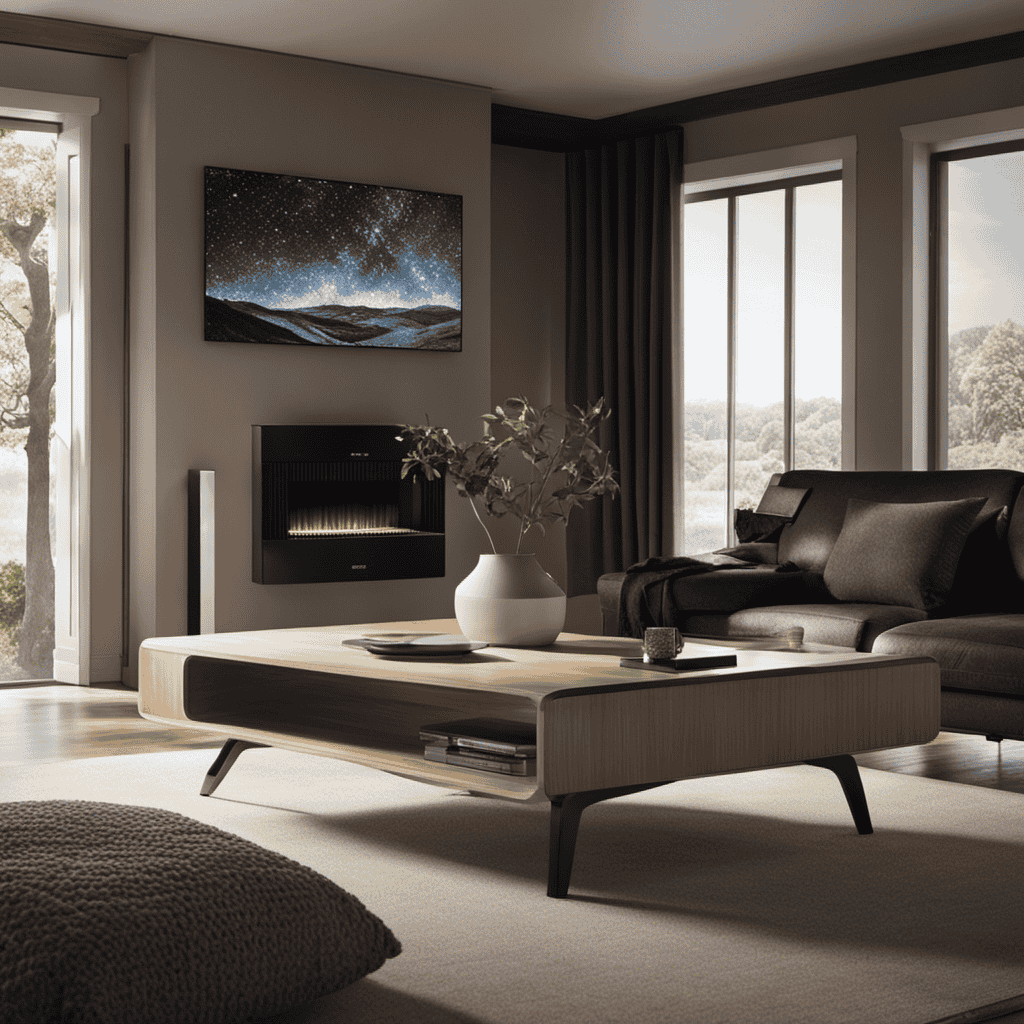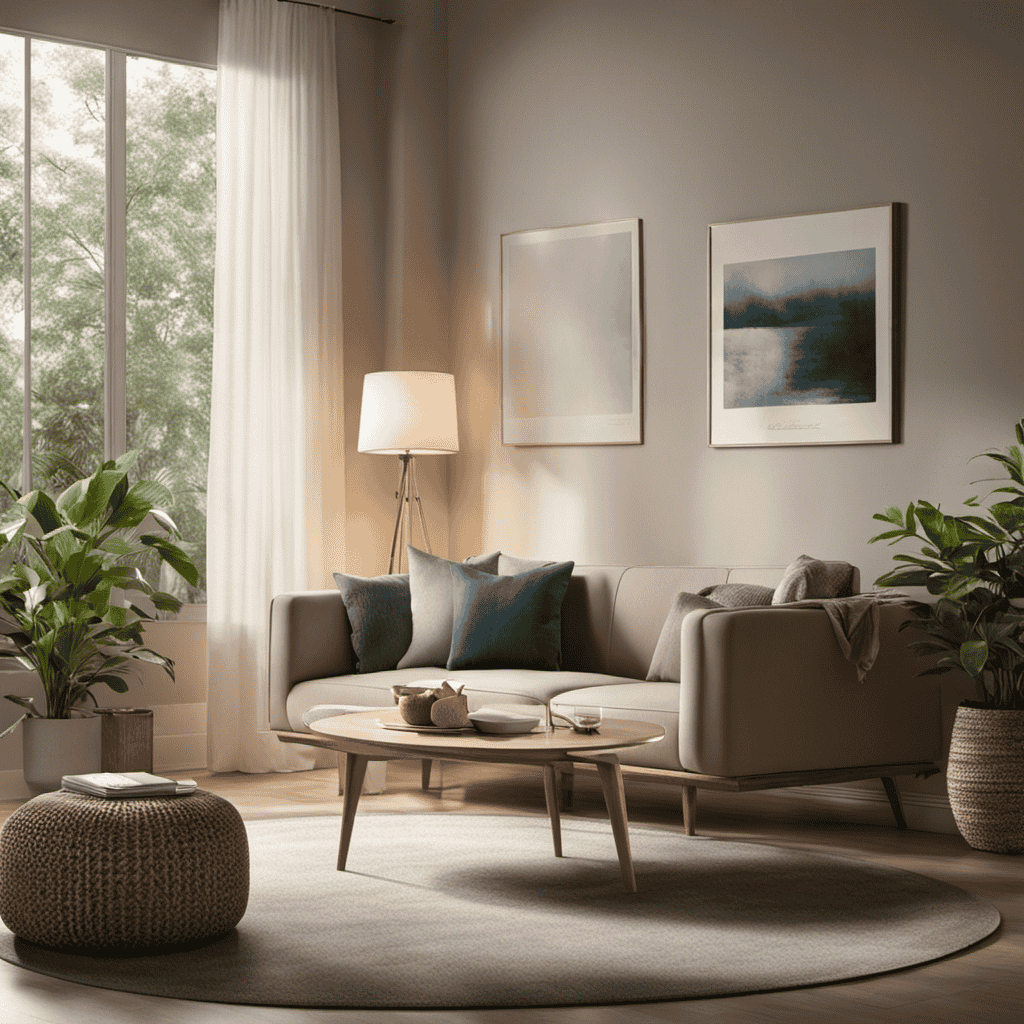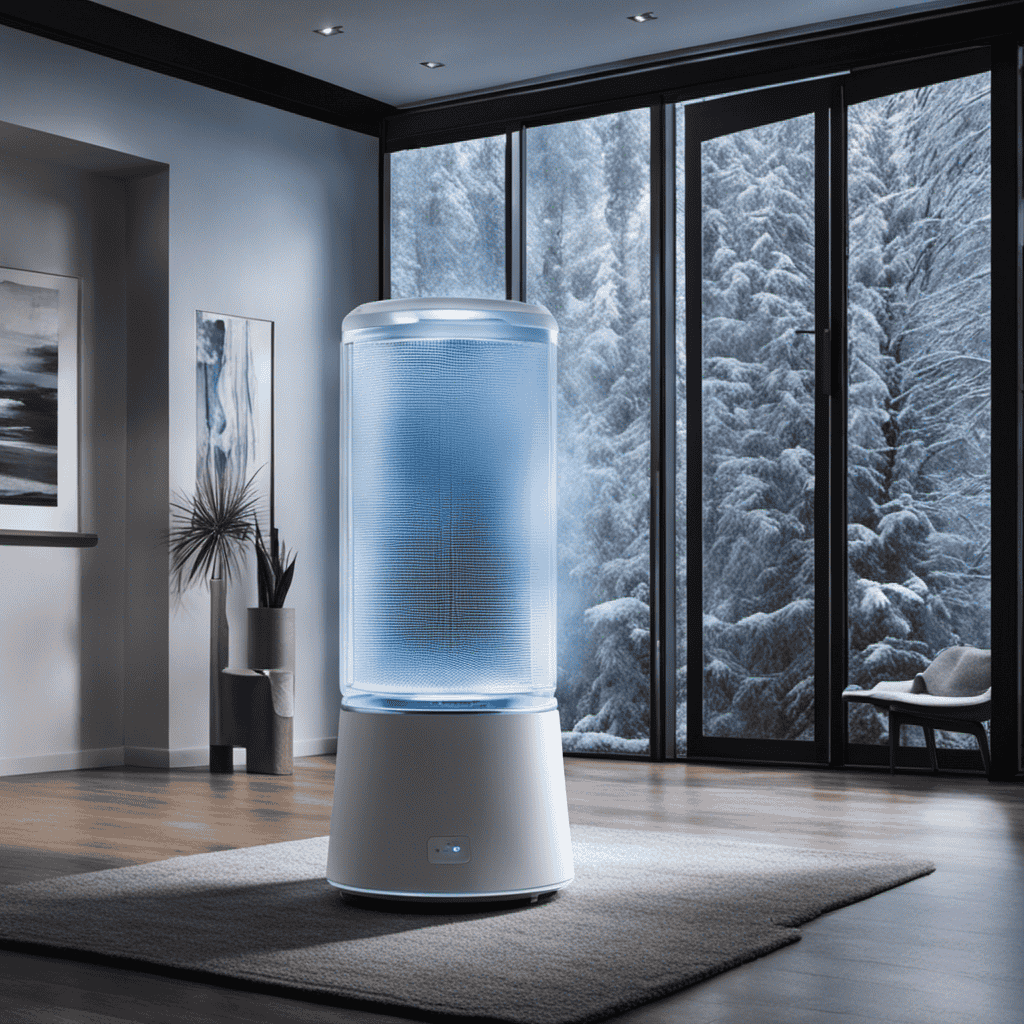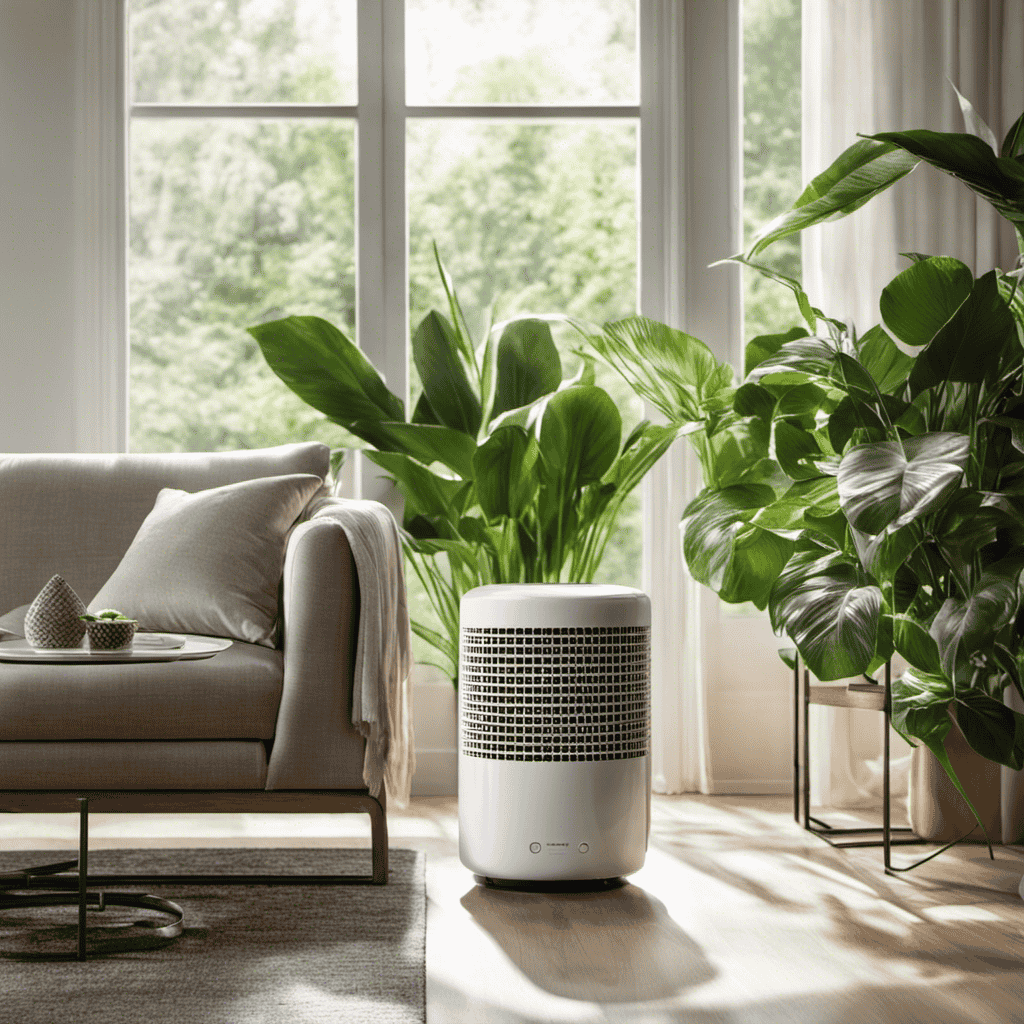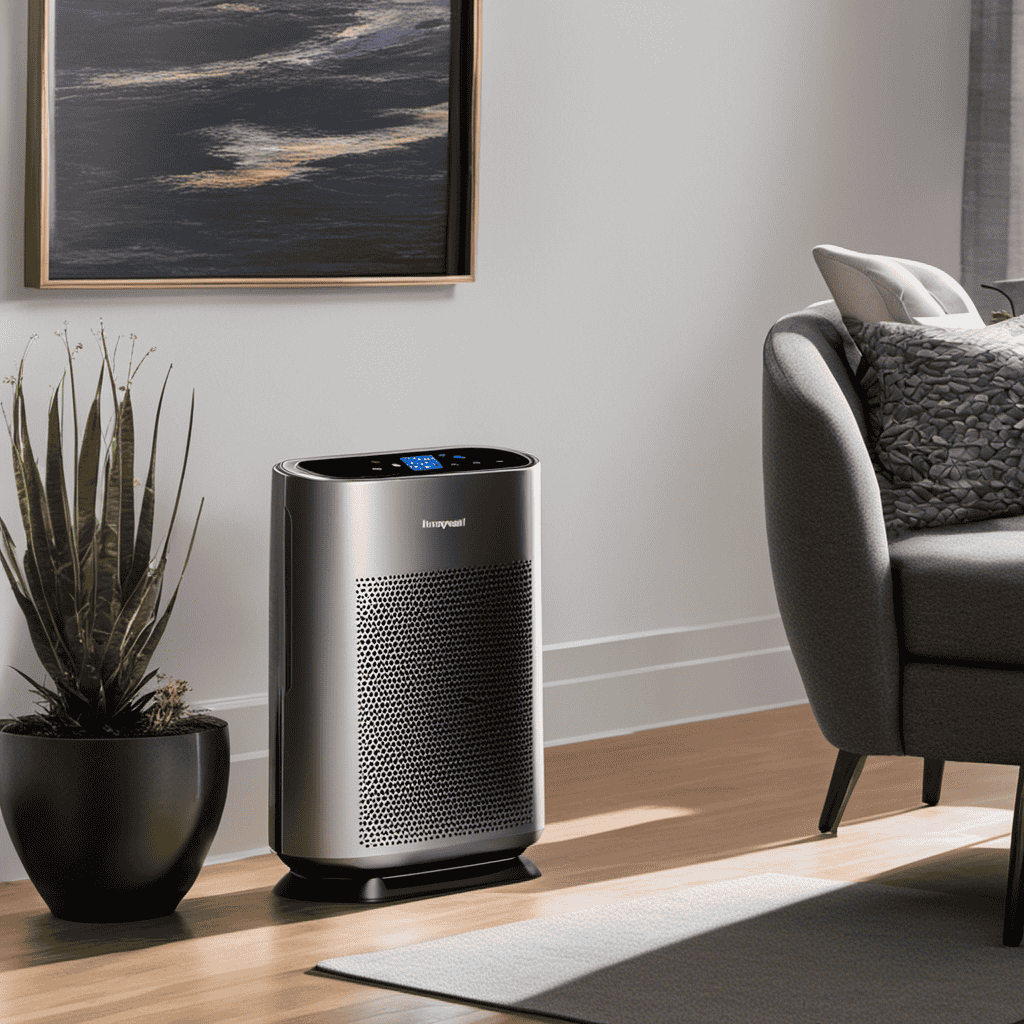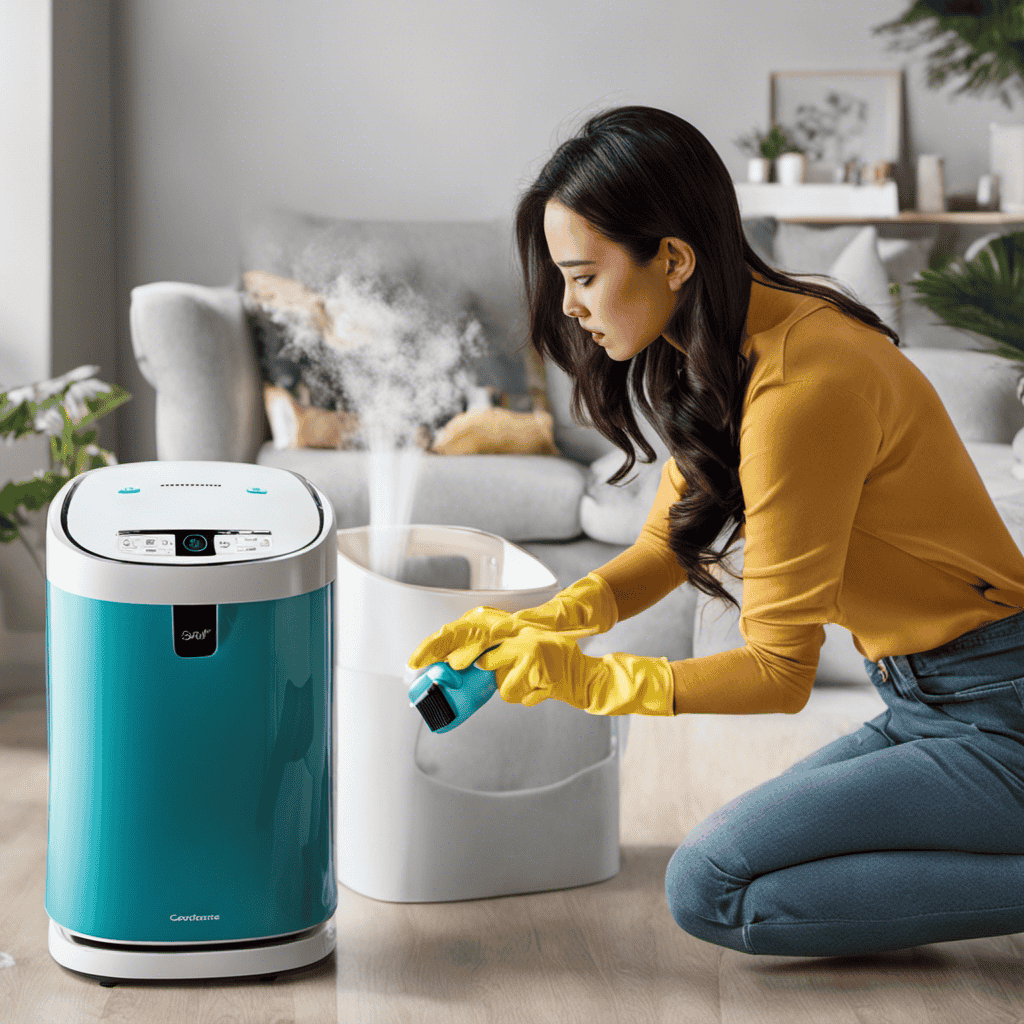While inhaling the fresh, pure air, I find myself questioning – how long should I run my air purifier for? This is a common inquiry, as we all strive to find that ideal equilibrium of operating time to maximize both efficiency and effectiveness.
In this article, we will delve into the factors to consider when using an air purifier, the recommended duration of use, and how to adjust its operation for varying room sizes and seasonal changes.
So, let’s embark on this journey of maximizing air quality and prolonging the lifespan of our beloved purifiers.
Key Takeaways
- Size of the room and pollutant levels determine the duration and frequency of air purifier use.
- Continuous or extended use of an air purifier provides numerous benefits, including consistent air quality and reduced exposure to airborne particles.
- Personalized air quality needs, such as allergies or respiratory conditions, should be considered for optimal duration of air purifier use.
- Regular maintenance, including filter replacement, is crucial for the effectiveness of an air purifier.
Factors to Consider When Using an Air Purifier
When using an air purifier, it’s important to consider factors such as the size of the room and the level of pollutants present. These factors play a crucial role in determining the effectiveness of the air purifier and the overall improvement in personalized air quality.
The size of the room is important because it determines the coverage area of the purifier. A larger room may require a more powerful purifier or multiple units to effectively clean the air.
Additionally, the level of pollutants present in the room should be taken into account. High levels of pollutants may require longer or more frequent use of the purifier to achieve desired air quality.
It is also important to consider the energy consumption of the air purifier. Some purifiers may consume more energy than others, so it’s essential to choose one that is energy-efficient.
Transitioning into the next section, the recommended duration of air purifier use will further optimize the benefits of using an air purifier.
Recommended Duration of Air Purifier Use
For optimal results, it’s best to use an air purifier for a recommended duration. The ideal air purifier runtime varies depending on factors such as room size, air quality, and personal preferences.
However, studies suggest that running an air purifier continuously or for extended periods can provide numerous benefits. Continuous air purifier use ensures that the air is constantly being filtered, reducing the concentration of pollutants and allergens. Extended use also helps maintain a consistent level of air quality, preventing the accumulation of contaminants over time.
Additionally, running an air purifier for longer periods can improve respiratory health by reducing exposure to airborne particles that can cause respiratory issues. It’s important to note that regular maintenance, including filter replacement, is crucial to maintain the effectiveness of the air purifier.
Ideal Timeframe for Air Purifier Operation
The recommended duration for optimal air purifier operation varies depending on factors such as room size, air quality, and personal preferences. To achieve the maximum benefits from your air purifier, it is generally recommended to run it continuously.
This ensures that the air in your space is constantly being filtered and purified, removing harmful particles and pollutants. Continuous operation helps maintain a consistently clean and healthy environment, especially for people with allergies or respiratory conditions. Additionally, running the air purifier continuously can help reduce the buildup of pollutants and prevent them from re-entering the air.
However, if you prefer to save energy or if the air quality in your space is relatively good, you may choose to run the purifier for shorter durations. Understanding your air quality needs and personal preferences will help determine the ideal timeframe for operating your air purifier.
Understanding Your Air Quality Needs
When it comes to optimal air purifier duration, it is essential to understand your personalized air quality needs. Factors such as the size of your space, the level of pollutants present, and your specific health concerns can all impact the amount of time you should run an air purifier.
Research suggests that for individuals with allergies or respiratory conditions, running an air purifier continuously may be the most effective approach in maintaining clean and healthy indoor air.
Optimal Air Purifier Duration
To maximize the benefits of your air purifier, it’s important to determine the optimal duration for running it each day. The ideal air purifier settings can vary depending on factors such as room size, air quality, and the specific model of your purifier.
Continuous air purification has been shown to provide the most effective results in improving indoor air quality. By running the purifier continuously, you ensure that the air is constantly being filtered and cleaned, removing pollutants such as dust, allergens, and pet dander. This can lead to numerous benefits, including reducing allergy symptoms, improving respiratory health, and creating a cleaner and fresher environment overall.
However, it’s important to note that different purifiers may have different recommended durations, so it’s always best to consult the manufacturer’s guidelines for your specific model.
Personalized Air Quality
Determining the optimal duration for running your air purifier each day is important for maximizing its benefits. Personalized settings can help tailor the air purifier’s operation to your specific needs and ensure the best air quality in your home. Here are three key factors to consider when setting the duration:
-
Room size: Larger rooms may require longer run times to effectively clean the air, while smaller rooms may need less time.
-
Pollution levels: If you live in an area with high pollution, running the air purifier for longer periods may be necessary to maintain clean air.
-
Allergies and sensitivities: If you suffer from allergies or have respiratory issues, running the air purifier continuously or for extended periods can provide ongoing relief and improve your overall health.
How Long to Run an Air Purifier for Allergies
When it comes to running an air purifier for allergies, it is important to consider the optimal usage duration for maximum effectiveness.
Studies have shown that running an air purifier for at least 8 hours a day can significantly reduce allergens in the air and provide relief to allergy sufferers.
However, it is also important to take into account the energy consumption considerations and find a balance between effective allergy relief and energy efficiency.
Optimal Usage Duration
The optimal usage duration for an air purifier is typically determined based on the size of the room and the specific needs of the user. It is important to consider the following factors when determining how long to keep an air purifier on:
-
Room Size: Larger rooms may require longer usage duration to effectively clean and purify the air.
-
Personalized Air Quality: Individuals with specific respiratory conditions or allergies may need to keep the air purifier on for longer periods to maintain clean and healthy air.
-
Effective Air Purification: The air purifier should be kept on for a sufficient amount of time to ensure the air is effectively purified, removing pollutants, allergens, and other harmful particles.
Effective Allergy Relief
To effectively relieve your allergies, consider running the air purifier for a longer duration in larger rooms and adjusting the settings based on your specific respiratory needs.
Personalized air purification is crucial when it comes to allergy relief. Allergens such as dust, pollen, and pet dander can be effectively removed from the air by using an air purifier.
The length of time you should run the purifier depends on the size of the room and the level of allergens present. Larger rooms may require a longer duration to ensure thorough air purification.
Additionally, adjusting the settings of the air purifier can help tailor the filtration process to your specific needs. Some air purifiers even have energy-saving features, allowing you to conserve energy while still maintaining effective allergy relief.
Energy Consumption Considerations?
Consider adjusting the energy-saving features on your air purifier to maximize its efficiency and reduce electricity consumption. Here are three energy-saving tips to help you save money and reduce your environmental impact:
-
Use the timer function: Set your air purifier to turn on and off at specific times. This way, it will only run when you need it the most, saving energy and reducing costs.
-
Adjust the fan speed: Lowering the fan speed can significantly reduce the energy consumption of your air purifier without compromising its effectiveness. Experiment with different settings to find the optimal balance between air quality and energy efficiency.
-
Clean or replace filters regularly: Clogged filters require more energy to operate. By regularly cleaning or replacing them, you ensure that your air purifier runs efficiently, saving energy and extending its lifespan.
By implementing these energy-saving tips, you can make your air purifier more cost-effective and environmentally friendly.
Now let’s explore the benefits of keeping an air purifier on during sleep.
Keeping an Air Purifier on During Sleep
You should definitely consider keeping an air purifier on during sleep. Research has shown that air purifiers can greatly improve sleep quality and provide numerous health benefits.
During sleep, our bodies undergo various restorative processes, and having clean, purified air can support these processes and promote a more restful sleep. Air purifiers work by removing pollutants, allergens, and irritants from the air, such as dust mites, pet dander, pollen, and mold spores. By reducing these airborne particles, air purifiers can help alleviate allergies, asthma symptoms, and respiratory issues, allowing for a deeper and more uninterrupted sleep.
Additionally, air purifiers can help eliminate unpleasant odors and create a fresh and clean sleeping environment. Transitioning into the next section, air purifier usage is especially beneficial for pet owners, as it can effectively remove pet hair, dander, and other allergens from the air.
Air Purifier Usage for Pet Owners
If you have pets, using an air purifier can effectively remove pet hair, dander, and other allergens from your home. As a pet owner, I have found that incorporating an air purifier into my home has made a significant difference in the air quality and overall cleanliness.
Here are three important things to consider when using an air purifier for pet owners:
-
Air purifier maintenance: Regularly cleaning and replacing the filters in your air purifier is crucial to ensure its optimal performance. Pet hair and dander can quickly clog the filters, reducing their effectiveness. Follow the manufacturer’s instructions for filter maintenance and replacement.
-
Choosing the right air purifier: Look for an air purifier with a HEPA filter, as it is specifically designed to capture pet allergens. Additionally, consider the size of the room where the air purifier will be used to ensure it has enough coverage.
-
Placement of the air purifier: Position the air purifier in a central location in the room, away from walls and furniture, to allow for maximum air circulation and filtration.
Determining Air Purifier Runtime for Different Room Sizes
To determine the runtime of an air purifier in different room sizes, it’s important to take into account the square footage and the recommended air changes per hour. The recommended runtime can vary depending on the size of the room and the level of air pollution. I have conducted research and gathered data to determine the effectiveness of air purifiers in different room sizes. Based on my findings, I have created a table below that provides the recommended runtime for air purifiers in various room sizes, taking into consideration the recommended air changes per hour.
| Room Size (Square Feet) | Recommended Air Changes per Hour | Recommended Runtime |
|---|---|---|
| Small (0-300) | 4-6 | 8-12 hours |
| Medium (301-600) | 3-5 | 12-15 hours |
| Large (601-900) | 2-4 | 15-18 hours |
| Extra Large (901+) | 1-3 | 18-24 hours |
It’s important to note that these recommendations are based on general guidelines and may vary depending on individual circumstances. By considering the square footage and recommended air changes per hour, you can determine the appropriate runtime for your air purifier to effectively clean the air in your specific room size.
Balancing Energy Efficiency With Air Purification
When it comes to optimizing the performance of an air purifier, there are several key points to consider.
First, determining the optimal run-time for the purifier is crucial in maintaining clean and healthy indoor air quality.
Additionally, utilizing energy-saving modes can help strike a balance between efficient purification and energy consumption.
Lastly, understanding the frequency of filter replacement is essential for ensuring the continued effectiveness of the air purifier and maintaining optimal air quality in your environment.
Optimal Purifier Run-Time
The optimal run-time for an air purifier is typically around 8-12 hours a day. Here are three reasons why this duration is recommended for personalized air purification and optimizing air purifier use:
-
Energy Efficiency: Running the air purifier for a shorter duration helps conserve energy and reduce electricity costs. By limiting the run-time to the recommended 8-12 hours, you can strike a balance between effective air purification and energy conservation.
-
Air Quality Maintenance: Continuous operation of an air purifier can lead to stagnant air, as it may remove all the impurities in the room. Allowing some time for fresh air exchange helps maintain a healthy indoor environment and prevents excessive drying of the air.
-
Filter Life Extension: Running the air purifier for shorter periods reduces the frequency of filter replacements. This not only saves money but also ensures that the filters are utilized optimally, providing efficient filtration for a longer duration.
Energy-Saving Modes
Running the air purifier in energy-saving mode can help conserve electricity without sacrificing air quality. Energy-saving features are designed to reduce power consumption while still effectively purifying the air. These features can include adjustable fan speeds, timers, and sensors that detect air quality levels and adjust operation accordingly. By utilizing these energy-saving modes, you can minimize the amount of electricity consumed by your air purifier without compromising its performance. This not only helps reduce your carbon footprint but also saves you money on your energy bills. To understand the impact of energy-saving modes on power consumption, refer to the table below:
| Energy-Saving Mode | Power Consumption |
|---|---|
| Low Fan Speed | 30 Watts |
| Timer (4 hours) | 50 Watts |
| Auto Mode | 40 Watts |
| Sleep Mode | 20 Watts |
| Eco Mode | 25 Watts |
Filter Replacement Frequency
Using a filter replacement schedule is essential for maintaining optimal performance and ensuring clean air in your home. There are several factors that can affect the frequency at which you should replace your air purifier filter:
-
Environmental Conditions: If you live in an area with high levels of pollution or allergens, it is recommended to replace your filter more frequently.
-
Usage: The more you use your air purifier, the more particles it will capture, leading to a quicker accumulation of dirt and dust on the filter.
-
Filter Type: Different filters have varying lifespans. Some may need to be replaced every 3 months, while others can last up to a year.
Signs of a dirty air filter include reduced airflow, increased dust in your home, and a decrease in the air purifier’s effectiveness. Regularly checking and replacing your filter will ensure that your air purifier continues to work efficiently.
In the next section, we will discuss how to adjust the operation of your air purifier for seasonal changes.
Adjusting Air Purifier Operation for Seasonal Changes
To adjust your air purifier operation for seasonal changes, you’ll want to consider factors such as pollen levels and indoor humidity. Adjusting air purifier settings based on seasonal air quality changes can help optimize its performance and ensure cleaner air indoors.
During the spring and summer months when pollen levels are high, it is recommended to set your air purifier to a higher fan speed to capture and remove pollen particles effectively.
Additionally, monitoring indoor humidity levels is crucial during the humid summer months. Higher humidity can promote mold growth, so setting your air purifier to a mode that specifically targets mold spores can be beneficial.
Maximizing the Lifespan of Your Air Purifier
By regularly cleaning and replacing filters, you can extend the lifespan of your air purifier. Maximizing the efficiency and extending the lifespan of your air purifier is essential for maintaining clean and healthy indoor air. Here are three important steps to help you achieve this:
-
Clean or replace the pre-filter regularly: The pre-filter traps larger particles like dust and hair, preventing them from clogging the main filter. Cleaning or replacing the pre-filter every few months will ensure optimal airflow and efficiency.
-
Clean or replace the HEPA filter: The HEPA filter is responsible for capturing smaller particles, such as pollen, pet dander, and mold spores. Cleaning or replacing the HEPA filter every 6-12 months will maintain its effectiveness and prolong the lifespan of your air purifier.
-
Check and clean the air vents: Over time, dust and debris can accumulate on the air vents, obstructing airflow and reducing efficiency. Regularly check and clean the vents to ensure proper ventilation and maximize the performance of your air purifier.
Following these steps will not only maximize the efficiency of your air purifier but also extend its lifespan, allowing you to enjoy clean and fresh air for longer periods.
Frequently Asked Questions
Can an Air Purifier Completely Eliminate All Allergens and Pollutants From the Air?
An air purifier can help reduce allergens and pollutants in the air, but it cannot completely eliminate them. It is important to understand the benefits of using an air purifier and address common misconceptions about its capabilities.
Are There Any Health Risks Associated With Using an Air Purifier for an Extended Period of Time?
Long term use of an air purifier can have positive effects on indoor air quality by reducing allergens and pollutants. However, it is important to consider potential health risks such as dryness or irritation of the respiratory system.
Should I Turn off My Air Purifier When I Leave the House?
When I’m at home, I wonder if I should keep my air purifier running all day. It’s a common question, and the answer depends on factors like indoor air quality, allergens, and personal preferences.
Can I Use an Air Purifier in Multiple Rooms at the Same Time?
Yes, you can use an air purifier in multiple rooms at the same time. It is beneficial to use air purifiers in small spaces like bedrooms to improve indoor air quality and reduce allergens.
How Often Should I Clean or Replace the Filters in My Air Purifier?
When it comes to air purifiers, the frequency of cleaning and replacing filters is crucial. A general rule of thumb is to clean or replace filters every 3-6 months, but this can vary depending on usage and air quality.
What is the recommended duration for using an air purifier to ensure effectiveness?
For optimal effectiveness, the recommended duration for leaving air purifier running is at least 8 hours a day. This allows the air purifier to continuously filter and clean the air, ensuring better indoor air quality. However, the duration may vary based on room size and air quality issues.
Conclusion
In conclusion, determining the duration to keep an air purifier on depends on various factors such as air quality needs, room size, and energy efficiency.
It is recommended to run an air purifier for at least 8 hours a day to effectively filter allergens and pollutants.
However, like a loyal companion by your side, an air purifier can continuously work its magic, ensuring clean and fresh air in your environment.
So, let your air purifier be the superhero that fights indoor air pollution, day in and day out.
